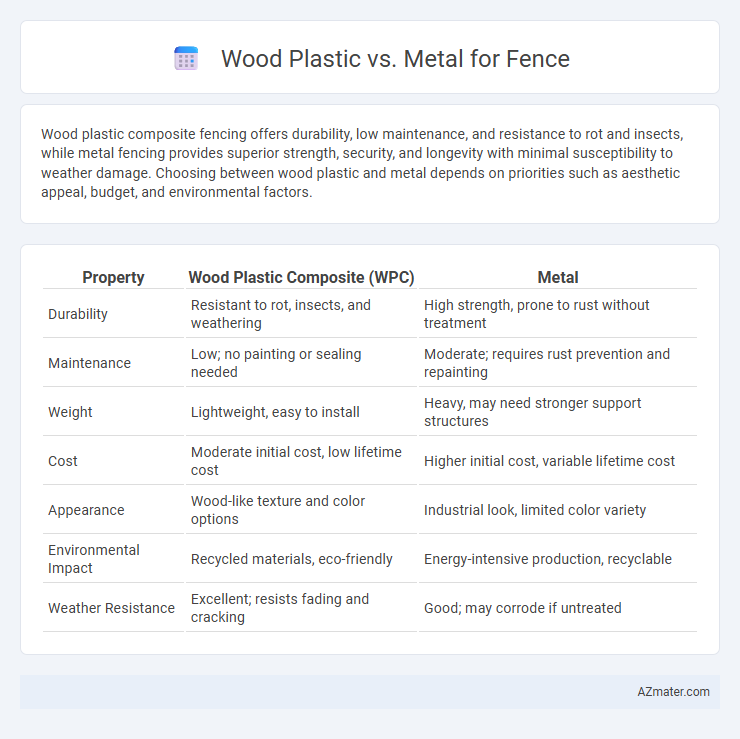Wood plastic composite fencing offers durability, low maintenance, and resistance to rot and insects, while metal fencing provides superior strength, security, and longevity with minimal susceptibility to weather damage. Choosing between wood plastic and metal depends on priorities such as aesthetic appeal, budget, and environmental factors.
Table of Comparison
| Property | Wood Plastic Composite (WPC) | Metal |
|---|---|---|
| Durability | Resistant to rot, insects, and weathering | High strength, prone to rust without treatment |
| Maintenance | Low; no painting or sealing needed | Moderate; requires rust prevention and repainting |
| Weight | Lightweight, easy to install | Heavy, may need stronger support structures |
| Cost | Moderate initial cost, low lifetime cost | Higher initial cost, variable lifetime cost |
| Appearance | Wood-like texture and color options | Industrial look, limited color variety |
| Environmental Impact | Recycled materials, eco-friendly | Energy-intensive production, recyclable |
| Weather Resistance | Excellent; resists fading and cracking | Good; may corrode if untreated |
Introduction to Fence Material Choices
Wood plastic composite (WPC) and metal are popular fence material choices offering unique benefits for residential and commercial properties. WPC fences combine durability and low maintenance with a natural wood appearance, resisting rot and insect damage better than traditional wood. Metal fences, often made from steel or aluminum, provide superior strength, security, and longevity, withstanding harsh weather conditions and requiring minimal upkeep.
Overview of Wood Plastic and Metal Fencing
Wood plastic composite fencing combines recycled wood fibers and plastic, offering durability, low maintenance, and resistance to rot, insects, and warping. Metal fencing, typically made from steel or aluminum, provides strong security, corrosion resistance with coatings, and a sleek, modern appearance. Both materials present distinct benefits: wood plastic excels in environmental sustainability and aesthetic versatility, while metal fencing offers superior strength and longevity.
Durability Comparison: Wood Plastic vs Metal
Metal fences offer superior durability compared to wood plastic composites, resisting impacts, weathering, and corrosion more effectively over time. Wood plastic fences may fade, warp, or crack under extreme conditions, whereas metal types such as aluminum or steel maintain structural integrity with proper maintenance. Longevity and resistance to pests and moisture make metal fences a preferred choice for long-term durability in outdoor applications.
Maintenance Requirements for Each Material
Wood plastic composite fences require minimal maintenance, as they resist rot, insect damage, and do not need painting or staining. Metal fences, typically made from aluminum or steel, demand regular inspections for rust and corrosion, especially in humid or coastal areas, with occasional repainting or treatment needed to maintain appearance and durability. Both materials offer long-lasting fencing solutions, but wood plastic composites provide lower upkeep efforts compared to metal options.
Aesthetic Appeal: Design and Finish Options
Wood plastic composite fences offer a versatile range of design styles and finishes, closely mimicking natural wood with textures and colors that enhance aesthetic appeal without the maintenance issues of real wood. Metal fences, available in wrought iron, aluminum, and steel, provide sleek, modern, and ornate decorative options with powder-coated finishes for durability and vibrant color retention. Choosing between wood plastic and metal for fencing depends on the desired combination of design flexibility and long-lasting surface aesthetics tailored to specific architectural preferences.
Cost Analysis: Initial Investment and Lifespan
Wood plastic composite (WPC) fencing generally has a higher initial investment than metal fencing, but offers lower maintenance costs over time due to its resistance to rot, rust, and insects. Metal fences, such as aluminum or steel, typically cost less upfront but may require periodic painting or rust treatment, increasing long-term expenses. Considering lifespan, WPC fences can last 25 to 30 years, while metal fences often exceed 30 years if properly maintained, impacting the total cost of ownership in fence planning.
Environmental Impact and Sustainability
Wood-plastic composite fences offer enhanced sustainability by utilizing recycled plastics and reclaimed wood fibers, reducing landfill waste and minimizing deforestation. Metal fences, primarily made from steel or aluminum, provide long-term durability and are highly recyclable, though their production involves intensive mining and energy consumption. Evaluating environmental impact, wood-plastic composites deliver a balance between resource efficiency and waste reduction, while metal fences excel in lifespan and recyclability but carry a higher upfront ecological cost.
Installation Process and Flexibility
Wood plastic composite fences offer easier installation due to lightweight panels and pre-drilled holes, requiring minimal tools and reducing labor time. Metal fences, often made from steel or aluminum, demand heavier equipment and skilled labor to handle welding or bolting, increasing installation complexity. Wood plastic fences provide greater flexibility in design customization and modifications post-installation, while metal fencing offers limited adjustability once secured.
Security and Privacy Considerations
Wood plastic composite fences provide enhanced privacy due to their solid panels and limited gaps, effectively blocking visibility and reducing noise transmission. Metal fences, such as wrought iron or aluminum, offer superior security with their sturdy, durable construction and resistance to cutting or climbing, but typically have open designs that limit privacy. Choosing between wood plastic and metal fencing depends on prioritizing full visual obstruction for privacy against reinforced physical barrier requirements for security.
Conclusion: Choosing the Right Fence Material
Selecting between wood plastic composite (WPC) and metal for fencing depends on factors such as durability, maintenance, and aesthetic preferences. WPC offers resistance to rot, low maintenance, and a natural wood-like appearance, ideal for homeowners seeking a blend of aesthetics and practicality. Metal fences, typically made from aluminum or steel, provide superior strength, security, and longevity, making them suitable for high-security areas or modern designs.

Infographic: Wood plastic vs Metal for Fence
 azmater.com
azmater.com